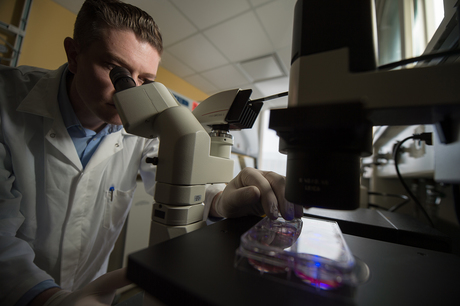A new kind of stem cell

Michigan State University (MSU) scientists have discovered a new kind of stem cell that could lead to advances in regenerative medicine, as well as offer new ways to study birth defects and other reproductive problems. Their study, led by Tony Parenti, has been published in the journal Stem Cell Reports.
Pluripotent stem cells, which are the focus of a great deal of stem cell research, can be created by reactivating embryonic genes to ‘reprogram’ mature adult cells. Reprogramming mature cells into induced pluripotent stem cells (iPS cells) allows them to become malleable building blocks that can morph into any cell in the body.
Prior to the discovery of reprogramming, scientists developed pluripotent stem cells from embryos. However, the embryo produces not only pluripotent stem cells, but also extraembryonic endoderm stem (XEN) cells. While pluripotent stem cells produce cells in the body, XEN cells produce extraembryonic tissues that play an essential but indirect role in foetal development. Parenti and his team speculated that if the embryo produces both pluripotent and XEN cells, this might also occur during reprogramming.
When Parenti discovered induced XEN cells (iXEN cells) popping up like weeds in his iPS cell cultures, he and his team used mice models to prove that the cells were not defective or cancer-like, as suspected by other scientists, but are in fact a new kind of stem cell with desirable properties. The team also found that by inhibiting expression of XEN genes during reprogramming, they could decrease production of iXEN cells and increase production of iPS cells.
“Nature makes stem cells perfectly, but we are still trying to improve our stem cell production,” Parenti said. “We took what we learned by studying the embryo and applied it to reprogramming, and this opened up a new way to optimise reprogramming.
“Rather than ignore these cells that have been mislabelled as waste by-products, we found gold in the garbage.”
The next steps of this research will involve seeing if this process occurs in human cells, where XEN cells are yet to be discovered, noted study co-author Amy Ralston.
“It’s true that XEN cells have characteristics that pluripotent stem cells do not have,” she said. “Because of those traits, iXEN cells can shed light on reproductive diseases. If we can continue to unlock the secrets of iXEN cells, we may be able to improve induced pluripotent stem cell quality and lay the groundwork for future research on tissues that protect and nourish the human embryo.”
Originally published here.
Specially designed peptides can treat complex diseases
Two separate research teams have found ways to create short chains of amino acids, termed...
Exposure to aircraft noise linked to poor heart function
People who live close to airports could be at greater risk of poor heart function, increasing the...
Predicting the impact of protein mutations with simple maths
Researchers have discovered that the impact of mutations on protein stability is more predictable...



